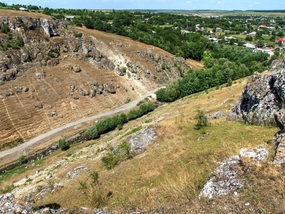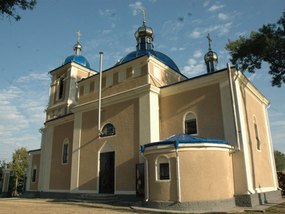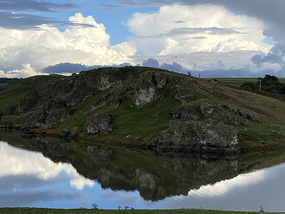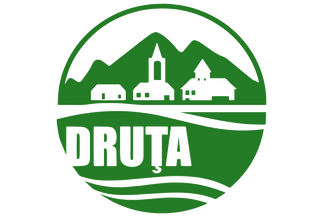Trinca
History
The first human settlements in the territory of the modern day Trinca and its surroundings date back to ancient times. The oldest settlement dates back to about 40 thousand years ago and refers to the Middle Paleolithic, along with the oldest settlements on the territory of Edinet district. The settlements were named Hulubilor (Pigeon) Cave and Scridon's Cave. These stations have been studied by archaeologists as short-lived settlements of hunters. Another period of colonization of the county refers to the Geto-Dacian culture, dating back to the 10th-9th centuries BC, when a village was formed on the banks of the Draghiște river, near the forest.
A new historical stage refers to the period of the 16th-17th centuries and corresponds to the Moldovan feudal culture. The first written document, in which the locality Șficicăuți - the first name of the village - is mentioned, dates from that period. The first information about the inhabitants of the village comes from the census of 1773-1774. According to the data there were 28 houses and the population was represented by 25 families. In their category the following family names are mentioned: Sorocan, Rosca, Mămăligă, Ivașco, Boboi, Voicul and Codreanu.
In 1809, Ecaterina Sturza owned the estate of Trinca village. According to the legend, it was during this period that the name of the village Sficicăuți was changed to Trinca. The name comes from the diminutive Ecaterina - Catinca - Tinca Sturza. The Sturza family remained owners of the estate until 1881. Later, the estate passed into the possession of the Stroescu family. It was here that their 15th child Vasile Stroescu, a famous Romanian philanthropist, was born.
During the 19th century, the village of Trinca expanded rapidly, from 28 houses recorded in 1774 to 118 households and a population of 1230 inhabitants.
Legend
The legend of Trincu and Dragos.
Legend has it that two shepherds came to these places and had flocks of sheep. One was called Dragoș and the other Trincu. They set up their sheepfolds on the bank of a river between the rocks and built houses behind the rocks. Thus, their families grew bigger and bigger and they named the occupied settlement Trinca, after the shepherd named Trincu, and the river was named Draghiște, after the shepherd named Dragoș.
Tridava legend
Another legend says that three shepherds stayed in these wonderful places. One of them had a beautiful daughter, like a fairy. It is said that Dragoș Voievod himself, while hunting in these places, saw her and immediately fell in love. A hot love followed at the mouth of a spring. After the departure of Dragos Voievod, the girl shed many tears over this spring and from it flowed a trickle of water, which later became the river Draghiște, from Dragos, from love, and the place near the two rocks is mentioned with the name Tridava. Tridava comes from the three shepherds - Tri and Dava from Moldova.
Beautiful places

Trinca Gorge
The Trinca Gorge was born thousands and thousands of years ago, when the Draghiste River was relentlessly digging into the lower Badenian-Sarmatian limestone reef. Thus, the picturesque landscape was created with a deep valley, surrounded by rocky walls, steep in places. On the slopes of these great toltres are located several grottoes that shelter the past. In these grottos time has stopped, here haunts the history and memories of the ancient world, which has left us evidence of its existence - skeletal remains of hunted animals and prehistoric Neanderthal people.
Read more
Trinca Church
Trinca Church is located on the territory of the village, on the road leading to the village of Constantinovca. It is an old, historical building, built in 1902 by Vasile Stroescu, blessed by Tsar Nicolai I and consecrated by the Bishop of Hotin in 1904.
Read more
Draghiște River
The hydronym Draghiște, according to the late scholar Ion Dron, is old, of Daco-Getic or old Romanian origin and passed through the Slavic lineage - draga (Bulgarian, Serbian, Slovenian), draha (Czech), droga (Polish), meaning in these foreign languages - "a strait, a gorge, a dip (in relief), a place where water drains, a valley and even a road; a path".
Read moreFigures
Vasile Stroescu (11 November 1845 - 13 April 1926)
It is inadmissible when talking about Trinca not to mention the great politician, scholar and philanthropist - Vasile Stroescu (1845-1926). Beyond his great deeds for his nation and country, Vasile Stroescu founded the church and the hospital in Trinca. On one of the buildings left behind there is a memorial plaque, made by the artist Valentin Vârtosu, on which the following text is inscribed: "Great Romanian patriot and philanthropist from Bessarabia, first president of the Chamber of Deputies of Great Romania".
Vasile Stroescu was born in the village of Trinca. He studied in Chisinau, Camenitsa, Odessa, Moscow, St. Petersburg and Berlin. A law graduate, Vasile Stroescu was passionate about history, literature and agricultural science. Vasile Stroescu knew many languages and was a great philanthropist, but he always said when doing something charitable: "I care about the nation's benefit, not my own".
He was a leading scholar, a supporter of school education and a Romanian Basarabian politician, philanthropist and honorary member of the Romanian Academy, who promoted the national and national culture.
Vasile Stroescu came from an old Romanian family, important and recognized since the end of the 17th century, being famous landowners.
He inherited nine thousand hectares of land from his father, and because he was very skilled he managed to triple the area. He inherited several estates from his parents, with a total area of 25,000 ha, including large herds of cattle, horses, flocks of sheep and numerous manors. All these possessions he placed at the service of the country, for the benefit of the peasantry "whom he loved, guided and helped" (Eugen Holban). He leased the land to the peasants and donated it to agricultural and forestry cooperatives. The large sum of money obtained from the sale of the properties was transferred to charitable funds for the construction of schools, churches and hospitals in all Romanian provinces - but especially in Transylvania/Ardeal, where Romanian schools were threatened by Hungarisation - to support cultural institutions, to print books and to provide scholarships for young students. Founder of the churches of Șofrîncani, Zăicani, Trinca, Pociumbăuți, founder of the hospitals of Trinca and Brătușeni, donor in support of the churches, hospitals and schools of Trinca, Stolniceni, Brînzeni etc. As a reward for his charitable acts and contribution to the awakening of the national conscience, he was elected as an honorary member of the Romanian Academy on 24 May 1910. He was also honorary president of the Moldovan National Party (1917), first president of the Parliament of Greater Romania (1919), senator of Transylvania.
Dumitru Bajureanu (21.10.1936-06.03.2009), born in Trinca village
He studied at the Republican School of Painting "Ilia Repin" in Chisinau in 1964-1965.
He was director of the school of painting for children in Calarasi. He returns to his native town and takes up a job at the Trinca middle school. He set about studying the locality of the village, gathering a rich collection of archaeological finds, working tools, cult objects, photographs and old attested documents. He collected old books, documents from the Tsarist period and valued the work of the Stroescu family. He wrote numerous verses, including "Ballad of the village" and "Draghiște, on your shore".
Ion Preașca (born 16 August 1967)
Well-known journalist, currently editor of RISE, former director of "Adevărul Republicii Moldova", editor-in-chief of "Business News Service". Studied at the Faculty of History, State University of Moldova. He has written an extensive essay on Vasile Stroescu, published in the collection of materials and documents presented at the Cultural Politic - historical and scientific namesake of the Basarabians of the world. Twice nominated journalist of the year by the Center for Independent Journalism. In parallel, he has conducted several investigations into privatizations of state-owned companies, electricity transactions, influence peddling and corruption cases.
Sergiu Popa, born in Trinca, on 9 April 1961
Rheumatologist. Senior category, doctor of medical sciences, university lecturer. Studied general medicine at the Nicolae Testemitanu University of Medicine and Pharmacy. In 1995 he defended his doctoral thesis in internal medicine and is a member of the Romanian Society of Rheumatologists. He was interim director of the Republican Hospital in Chisinau (2011-2015).
Victor Balan, born on 19 February 2000 in the village of Trinca
Folk music performer. He took singing lessons at the "Ghenadie Ciobanu" Music School in Edinet, graduated from the "Stefan Neaga" Music College in Chisinau, and is currently a student at the National University of Music in Bucharest.
He has participated in numerous national and international competitions and festivals. His debut pieces "Mi-a bătutul mălaiul bruma", "De ciobănie", "Cu drag parintilor" were accompanied by the "Rapsozii Moldovei" Orchestra.
Video presentation
In the following video presentation, you will be invited to discover the beauty of the banks of the Prut River in the Republic of Moldova. This picturesque area is known for its idyllic landscapes, where the river Prut flows quietly through the hills
photos by Iurie Sveț – www.hikeme.club


 ro
ro
 ru
ru























